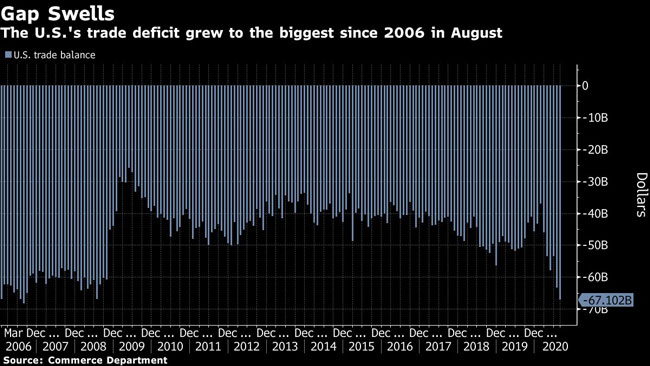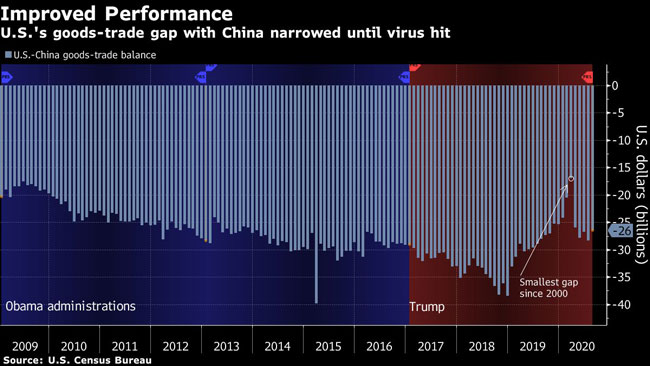Bloomberg News
US Trade Deficit Widened in August to Largest Since 2006

[Ensure you have all the info you need in these unprecedented times. Subscribe now.]
The U.S. trade deficit widened in August to the largest since 2006 as the nation imported a record amount of consumer goods amid a pickup in demand ahead of the holiday shopping season.
The overall gap in trade in goods and services expanded to $67.1 billion in August from a revised $63.4 billion in July, according to Commerce Department data released Oct. 6. The median estimate in a Bloomberg survey of economists had called for a widening to $66.2 billion. The positive balance on services dropped to $16.8 billion.
Total imports increased 3.2% to $239 billion, while exports rose 2.2% from the prior month to $171.9 billion. The nation’s surplus in services shrank to the lowest since 2012. Meanwhile, the merchandise trade deficit expanded to a record high.

The coronavirus pandemic undid some of the Trump administration’s deficit-reduction efforts that were starting to bear fruit before COVID-19 upended demand and supply chains. American businesses, which drew down inventories at the start of the lockdown, have recently increased imports to replenish stocks ahead of the holidays.
Meanwhile, depressed economic activity abroad has led to smaller improvements in exports of goods from the world’s biggest economy. Trade volumes are higher than May’s pandemic lows, but remain depressed following the initial uptick stemming from reopening measures.
U.S. Trade Representative Robert Lighthizer, who doesn’t usually comment on the monthly data, issued a lengthy statement on the numbers in which he defended President Donald Trump’s economic record, saying the latest deficit increase reflected imports of gold for “risk-hedging strategies,” while the goods gap with China narrowed.
“The trade data released today reflect the effects of the coronavirus on the U.S. and our trading partners. Basically, many of our partners were more negatively affected by the pandemic than we were,” he said. “As other countries recover and reopen, we expect both imports and exports to improve substantially.”
Together, the value of U.S. exports and imports climbed to almost $411 billion, still well below prepandemic levels.
The increase in imports of services outpaced the advance in exports, resulting in a lower overall surplus. Travel exports — which refer to tourists to the U.S. — declined for a sixth straight month and were down 77% from a year earlier.
Imports of services, ranging from insurance and financial services to construction and travel, rose to almost $36.1 billion.

This is the final release of data on trade in goods and services before the Nov. 3 election. Trade has been a keystone of Trump’s agenda, with his administration determined to minimize U.S. merchandise imports from China, which went from being America’s biggest trading partner at the end of 2017 to third-largest — after Mexico and Canada — by December 2019.
Trump’s strategy of imposing hundreds of billions of dollars of tariffs on imports of Chinese goods saw fewer products from the Asian nation arrive on U.S. shores, with the monthly goods-trade deficits gradually becoming smaller since late 2018.
The partial trade agreement signed in January was supposed to result in China buying an additional $200 billion in U.S. exports over two years. While the country is unlikely to reach the targets this year — partially because the pandemic upended demand and supply chains — it has made record purchases of American beef and corn, and has reiterated its commitment to the agreement.
Want more news? Listen to today's daily briefing:
Subscribe: Apple Podcasts | Spotify | Amazon Alexa | Google Assistant | More




